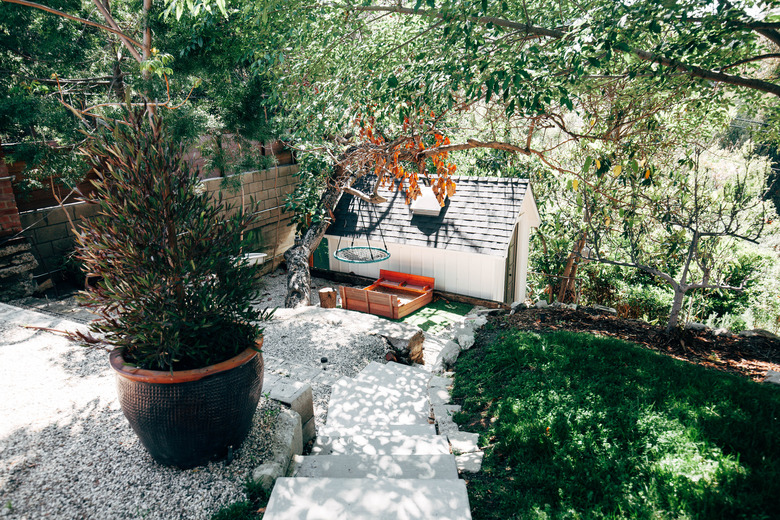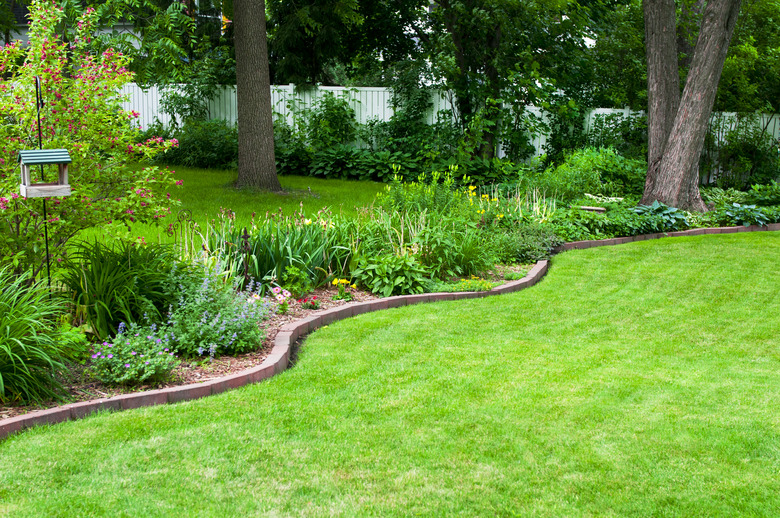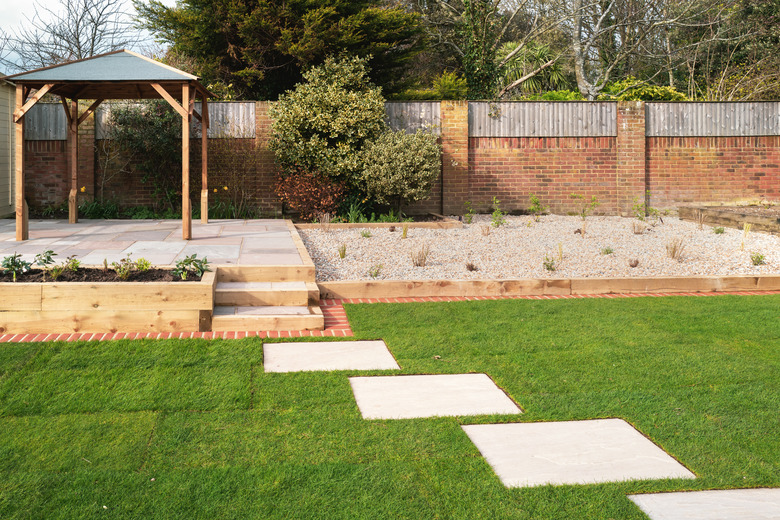The Best Types Of Landscape Edging
We may receive a commission on purchases made from links.
Landscaping edging can play a critical role in defining each area of your yard, dividing a flower bed, tree island or other decorative area from a lawn or from one another. While these divisions can help the overall aesthetic appearance of a yard, they can also make upkeep easier —preventing grass from growing into your roses and stopping gravel from your garden path from falling into your lawn and damaging lawn mower blades, for example. Because your choice of edging products can make such a big difference in how your yard looks and functions, always give serious consideration to the best lawn edging for your needs before buying and installing.
Plastic Landscaping Edging
Plastic Landscaping Edging
Plastic is one of the most popular lawn edging options. It is easy to work with, it can easily be installed along a curve and it is relatively inexpensive, according to Improvenet, costing anywhere between 35 cents and $3 per linear foot. Most plastic edging is 4 inches tall and is sold in varying lengths that can be cut shorter as needed. The majority are secured into the ground with included spikes.
Pros: Inexpensive, widely available and easy to use, it can conform to almost any shape. It holds up well against water and can be installed in an inconspicuous manner so you notice the garden around the edging rather than the edging material. It is available in a wide array of colors and can be made of eco-friendly, recycled materials.
Cons: While easy to install, plastic edging doesn't tend to stay put and often comes up at the seams. It is also not particularly durable and can crack when stepped on. Pay careful attention when mowing to avoid accidental damage to the lawn edging. It doesn't deter roots of many plants, particularly grass, as it tends to be sold in a 4-inch width and is so light that roots can push it out of the soil. It also fails to hold materials in place particularly well, such as gravel, mulch and eroding dirt. It can melt in excessive heat and can crack in excessive cold.
Steel Edging Options
Steel Edging Options
Metal edging is quite similar to plastic, only it is more heavy duty and a bit harder to cut. The most commonly used metals for garden edging are aluminum and steel. Steel edging is sold in three different heights so it can sit high above the ground, adding to the garden appearance, or installed lower into the ground to remain inconspicuous.
Galvanized steel edging is treated to prevent rust and is sold in an array of colors, including black, brown, green and silver. Steel edging also can be untreated, meaning it will start out silver and eventually take on a rust patina. Don't worry about the rust, as even untreated steel can still take 40 years before rusting to the point where the garden border needs to be replaced.
Pros: Steel edging is one of the most effective edging materials on the market, as it is stronger than both aluminum and plastic. It holds back grass, dirt, rocks and erosion better than plastic or aluminum. It does fine in both extreme cold and extreme heat and won't get damaged by lawn mowers, wheelbarrows or footsteps.
Cons: It is difficult to manipulate into sharp curves, so steel is best used with straight lines and gentle curves. It is also one of the most difficult edge materials to cut, making it difficult for DIYers to install. Steel edging can get expensive, with a starting point of less than $1 per foot but going as high as $15 per foot. One downside about steel edging is that it can be dangerously sharp if it is not made with a rolled-top edge. A safety cap can be added to the top of the edging, but if you were hoping to leave the edging exposed for style purposes, this will negatively affect the appearance.
Flexible Aluminum Edging
Flexible Aluminum Edging
Aluminum is similar to steel edging only it is more malleable, which makes it easier to install on curves. That malleability does make it more susceptible to damage, so it's best to keep aluminum low to the ground rather than trying to make it a decor feature. Also try to avoid placing weight on it when possible. The good news is that it also comes in a wide array of colors and will not rust, so it can remain an effective, inconspicuous garden divider for decades if it is well cared for.
Pros: It is stronger than plastic, so it is better able to hold back wandering grass and doesn't get pushed out of the ground. It does not rust, so it will not change its appearance, and it works well on curvy areas. Easier to cut than steel, it is a better option for DIY installs. Similar to steel, it averages about $2 a foot and does well in both extreme heat and cold.
Cons: It can get dinged and damaged easily, so it's best to avoid putting weight on it, and don't use it in areas with heavy erosion or beside gravel paths.
Brick and Paver Edging
Brick and Paver Edging
Few garden edging ideas look as classic as brick or concrete pavers. The grays, reds, browns and oranges of paver and brick edging suit many gardens but are particularly well-adapted to formal, cottage and vintage designs. Installation in a straight line is fairly straightforward, simply requiring you to dig a trench for the bricks to fit in and then knocking them in place with a rubber mallet. If you need to make cuts to fit an end piece or to build a curve, cutting these edging materials can be a bit difficult. Some designs are shaped with angled or curved edges that allow for more layout versatility without having to make cuts.
Bricks and pavers should either be installed low against the ground so they can be mowed over or installed partially above ground to create a more distinct barrier. When installed to create a barrier, there are many ways to lay out bricks and pavers. They can be set at a standard 90-degree angle or tilted at a 45-degree angle for a more visually interesting result. Alternatively, you may lay one or two rows of bricks flat into the ground and place a second row of bricks vertically behind the first row to create a small wall that's particularly eye-catching.
You can choose to lay bricks and pavers with or without mortar based on how much effort you want to put into the installation, how long you want the edging to last and the appearance you desire. Mortared designs are more effective dividers between garden areas, whereas bricks and pavers without mortar can still have plants grow between them, though placing the bricks together tightly can minimize this problem. Even when mortar is used, it's worth keeping in mind that brick edging set level with the ground doesn't stop anything from growing or crossing over the top.
Expect the price of bricks and pavers to vary considerably depending on the style, material and installation type. Concrete pavers can be reasonably affordable, coming in around $1.50 per foot. Bricks are more expensive, usually running between $3.50 and $5.50 per foot. When you're planning to construct a small wall, budget between $12 and $30 per linear foot depending on the brick type, wall height and whether or not mortar is used.
Pros: This type of edging adds instant curb appeal. It is easy to mow over when installed level with the ground and can be very durable, especially when installed in a sand or concrete base with mortar between bricks.
Cons: Cutting bricks and pavers can be particularly challenging, and shaping curves can be difficult. It is not always effective at dividing garden areas.
Natural Stone Edging
Natural Stone Edging
When it comes to landscaping edging that won't get damaged under even the toughest conditions, it's hard to beat the durability of natural stone. That being said, you'll want to use sand or concrete to keep the stones in place, or they may shift from where you originally place them. For best results, install stones at least 4 inches wide, thick and long so they can sit deep enough underground and be wide enough above ground to reduce grass from encroaching and mulch and other materials from crossing over your garden border.
Pros: Natural stone edging adds a visually interesting depth to your garden edge and fits a variety of styles, including cottage, natural and rustic designs. It can easily be installed in curved or straight lines since the rounded shape of the stones doesn't automatically go in straight lines the way bricks do. Other than lifting the stones, installation is fairly straightforward and simple.
Cons: Transporting and setting the stones can be difficult due to their weight. Stones offer limited color options, and if you want something more dramatic like white or black stones, expect to pay a hefty premium. If you like a uniform appearance, natural stones simply aren't right for you. Keeping plants from growing on the rocks can be challenging, and it is an expensive option, coming in at $12 to $18 per linear foot.
Wood Planks and Posts
Wood Planks and Posts
The great thing about wood edging is its versatility. Whatever garden look you're seeking, there's sure to be a wooden edging that will work. Wood can be stained or painted nearly any color. A quick search for wood landscaping edging on Amazon will show you just how many styles are available, ranging from straight boards that are similar to plastic edging all the way to designs that look like little picket fences.
Many people like the appearance of landscape timber. Others prefer smaller pieces of wood set vertically with a rubber mallet, which can be purchased individually or even ordered in a preassembled roll. When shopping, consider whether you want to incorporate many curves in your layout, as vertical wood pieces and bender boards are the best wood landscape edging options for creating curves.
Always buy wood that has been treated to resist rot and insects but be aware that even treated wood cannot survive wet conditions forever. Avoid using certain recycled wood products, such as railroad ties that have been treated with products that are toxic to plants. As for prices, expect properly treated wood edging to cost anywhere between $5 and $15 per linear foot depending on the type of edging and the wood.
Pros: Wood edging can last for a decade or more depending on the type of wood and where it is installed. While the versatility of wood edging makes it difficult to state absolutes about its effectiveness as edging, bender boards are stronger and more effective at blocking grass roots than plastic edging, and wood timbers are about as effective as bricks. For more effective borders that prevent mulch and gravel from leaving their designated garden areas, stick with taller options such as posts or small fences.
Cons: Exposure to dramatic temperature changes can result in cracking. High temperatures can result in fading. It cannot be left in continuously damp conditions, or the wood may begin to rot and grow mold and mildew. Timbers are difficult to use around curves.
Natural-Cut Edge
Natural-Cut Edge
If you like the look of distinct garden areas but don't particularly love the look of most landscaping edging, a natural-cut lawn edge (also known as the "Victorian edge" or "spade edge") might be the right option for you. Suburban Landscaping explains that this form of edging doesn't involve any external material but instead involves cutting the lawn edge with either a shovel or an edger. When using a shovel, the process involves using the flat edge to cut the grass at a 90-degree angle 3 to 4 inches deep and then digging a 45-degree trench to line up with the first cut. The trench should then be raked or filled with mulch.
Pros: It provides a clean, natural look with no distracting edging materials. There is no risk of damaging the edging while mowing or during installation. It is less expensive since it can be done with nothing but a shovel, and it can easily be modified to change the design of your garden area.
Cons: It can only be used on lawn edging and needs upkeep at least every year, sometimes as often as every few months depending on conditions. This means cutting the edge of the lawn with a shovel or edger to prevent grass from growing into the trench area.
References
- Homedit: 16 Lawn Edging Techniques Great For DIY Landscaping
- Total Landscape Care: How To: Edging Material Options and Installation
- Homesthetics: Best Lawn Edging for a Legendary Garden in 2020
- Improvenet: How Much Does Lawn Edging Cost?
- Landscape Associates: Which Landscape Edging is Best?
- Garden Tabs: How Much Does Garden Edging Cost?
- Sol Vida Landscaping: How Much Does it Cost to Install Stone Landscape Edging?
- Homewyse: Cost to Install Brick Edging
- Suburban Landscaping: Natural Bed Edging
- Gardenista: Hardscaping 101: Metal Landscape Edging


